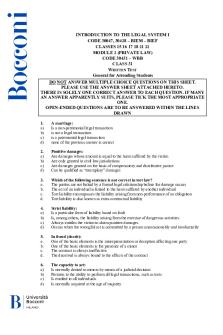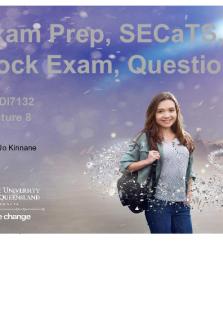MECO1001 Mock exam 2019 PDF

| Title | MECO1001 Mock exam 2019 |
|---|---|
| Course | Australian Media Studies |
| Institution | University of Sydney |
| Pages | 6 |
| File Size | 364.8 KB |
| File Type | |
| Total Downloads | 59 |
| Total Views | 145 |
Summary
Sample MECO1001 Mock paper for Final...
Description
Mock exam
DURATION: 2 HOURS plus 10 minutes reading time (do not write in this period) Instructions: There are THREE sections to this exam paper Sections A and B each have ONE question, each worth 10% of the overall mark. Section C has six essay questions. Select and respond to ONE essay question from the list. This is worth 10% of the overall mark. This examination is worth 30% of your overall mark in this unit of study. Ensure you read all the questions before you start. Read all the pages. Write clearly and double space if necessary (especially if your handwriting is untidy).
SECTION A – This section requires you to define terms/concepts encountered in the course, briefly explain their relevance to the study of media and communications and provide an example for each. You need to choose four (4). Possible options include: a) post-structuralism b) mediation/self-mediation c) narrative d) intertextuality e) exnomination f) genre g) interpellation h) mode of address i) signified/signifier j) essentialism k) representation l) imagined community m) catharsis n) semiotics o) connotation p) tele-cocooning q) agenda-setting r) transmission model s) essentialism t) mediation u) encoding/decoding v) polysemy x) media panic/moral panic y) textual poaching z) folk devil
Note that not all of the terms above are on the list in the exam. Therefore do not restrict your study to four of these.
SECTION B – There is only one (1) question. It requires you to analyse/do a close reading of a news transcript. To prepare for this question you will need to draw on theory from Saussure (1992), Fiske (1997), Dunn (2005) and other theorists encountered in this course to carry out a close reading of a news transcript. You will two identify strategies of containment and identify how television news uses narration and representation to create the ‘real’.
Hint: Refer to Fiske’s (1987, p.296-301) example of a news analysis to see how he traces strategies of containment at work and Dunn (2005) for news as narrative. Best references to prepare for this question: Dunn, Anne (2005), ‘TV News as Narrative’, in Fulton, Helen; Huisman, Rosemany, Murphet, Julian and Narrative and the Media, Melbourne, Cambridge University Press, pp. 140-152. Fiske, J. (1987). News readings, news readers. In his Television culture (pp. 281-308). London, Routledge. Tuchman, G. (1978). Making news: A study in the construction of reality. New York: Free Press.
The transcript in the exam closely resembles the one used in class in length and format, although it is a different topic. Here it is again for you to practice on.
SECTION C – A short essay. Select one (1) question only. Make sure you read all options there are six (6). The topics on which the questions are based are: Q1) Self-mediation Q2) The role of media in constructing ‘the nation’ Q3) Active and creative audiences Q4) Moral panics Q5) Mobile communication Q6) Representation of diversity in the Australian media
Hints for preparing for the short essay 1. Choose two topics from the list and prepare for both – always have a Plan B in case you don’t like the question provided for your preferred topic. 2. Try inventing a couple of questions that might be asked in relation to the two topics and write an essay plan for each, focusing on presenting a strong contention. 3. Identify at least two theorists who you plan to refer to in your analysis and memorise a few key quotes (we won’t be analysing these for accuracy and it is fine to paraphrase). DO name the theorists in your response and supply a year of publication. Page numbers are not necessary. 4. Detail at least one case study for each topic IN DEPTH. The more planning you do the more you will recall in the exam. 5. Get together and share your ideas in a study group. Practice writing essays and practice peer review....
Similar Free PDFs

MECO1001 Mock exam 2019
- 6 Pages

Mock exam 2019-2020
- 8 Pages

2019 Level II Mock Exam AM
- 48 Pages

Mock exam
- 3 Pages

Mock Exam - exam
- 8 Pages

Mock Exam - exam
- 4 Pages

SBL MOCK EXAM 1
- 16 Pages

Mock Final Exam - Questions
- 11 Pages

Revision & Mock Exam
- 22 Pages

Mock Exam C250 - Mock test questions
- 34 Pages

2020 nutrition mock exam
- 5 Pages

CFA Level 3 2019 Mock
- 51 Pages

FFA Mock Exam 3 - FFA Mock Exam 3
- 46 Pages

Mock final exam
- 9 Pages
Popular Institutions
- Tinajero National High School - Annex
- Politeknik Caltex Riau
- Yokohama City University
- SGT University
- University of Al-Qadisiyah
- Divine Word College of Vigan
- Techniek College Rotterdam
- Universidade de Santiago
- Universiti Teknologi MARA Cawangan Johor Kampus Pasir Gudang
- Poltekkes Kemenkes Yogyakarta
- Baguio City National High School
- Colegio san marcos
- preparatoria uno
- Centro de Bachillerato Tecnológico Industrial y de Servicios No. 107
- Dalian Maritime University
- Quang Trung Secondary School
- Colegio Tecnológico en Informática
- Corporación Regional de Educación Superior
- Grupo CEDVA
- Dar Al Uloom University
- Centro de Estudios Preuniversitarios de la Universidad Nacional de Ingeniería
- 上智大学
- Aakash International School, Nuna Majara
- San Felipe Neri Catholic School
- Kang Chiao International School - New Taipei City
- Misamis Occidental National High School
- Institución Educativa Escuela Normal Juan Ladrilleros
- Kolehiyo ng Pantukan
- Batanes State College
- Instituto Continental
- Sekolah Menengah Kejuruan Kesehatan Kaltara (Tarakan)
- Colegio de La Inmaculada Concepcion - Cebu

